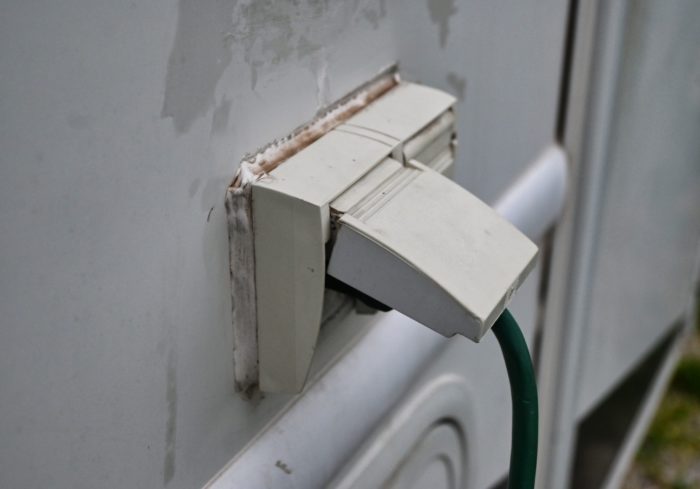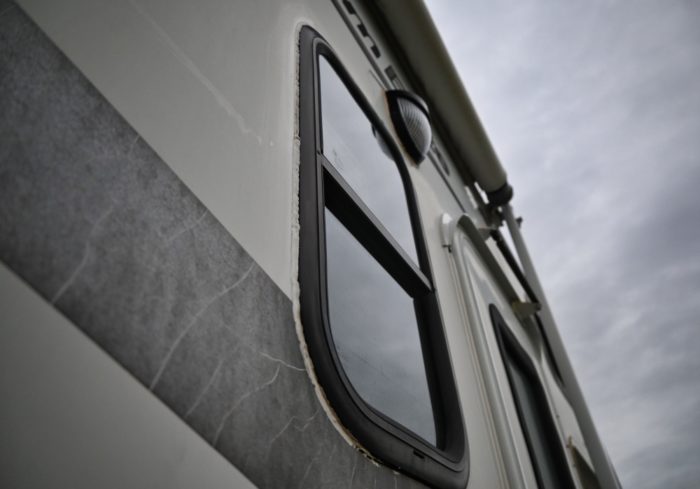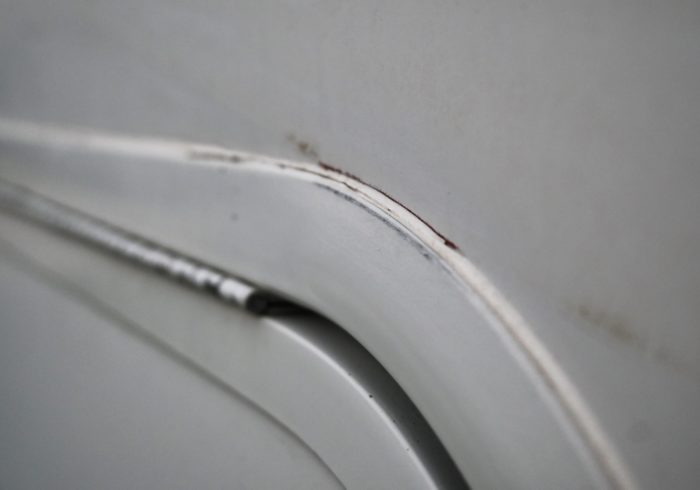What Kind Of RV Caulk Is Best For Outside My Camper?
When talking about RV caulks and sealants a lot of focus is put on the RV roof, but the sides of your camper need to be properly maintained as well.
All the trim around your RV’s windows, doors, lights, fixtures, and corners needs to be resealed regularly to be kept watertight and leak free.
Related RV Product: The Camco Screen Door Cross Bar Handle (click to view on Amazon) makes it easy to close an RV screen door and protect it at the same time.
It’s recommended to check all the caulking on your RV exterior every 6 months or in the beginning and at the end of every camping season.
It’s a job that’s often forgotten by RVers and it’s very common to see cracked and broken caulking along the trim of windows and storage doors.
It’s just as important to keep the outer walls of your RV from letting in water as it is for the RV roof.
It’s not as difficult of a task as it might seem. It’s often pretty easy to remove the old RV caulk and apply new.
And with the right kind of exterior RV caulk that’s made for vertical surfaces and strong enough to withstand weather, vibrations, and travel, your RV’s exterior won’t have to be resealed nearly as often.
See Also: Best RV Roof Caulks: When To Use Self Leveling Lap Sealants






Best Overall



Best For Experts


Best Silicone Based

Last update on 2024-04-18 / Affiliate links / Images from Amazon Product Advertising API
Best Exterior RV Caulks Reviews
1. Geocel Pro Flex RV Sealant
Geocel is hands down the most popular RV caulk among full-time RVers.
Everyone I’ve talked to uses this stuff and it’s gotten a lot of good feedback after years of being tested on campers that cover a lot of miles and see a lot of different kinds of weather year round.
Pro Flex (as many commonly call it) is a tripolymer based “synthetic rubber” RV sealant.
It’s perfect for sealing the exterior of campers and much more. It creates a tight bond to aluminum, glass, coated steel, Kynar 500 based finishes, steel, wood, fiberglass, and vynil.
It’s crack resistant, very flexible even after fully curing, can adhere in damp conditions, UV resistant, resists dirt, is mildew resistant, and paintable
On top of all of that, it’s easy to apply, especially when compared to some of the other polymer/rubber based RV caulks in this review.
Pro Flex can also adhere to itself. This is the main reason why RVers don’t like to use silicone based sealants to reseal their RVs.
See Also: What Are RV Roofs Made Of? A Quick Guide To Camper Roofs
If you see a crack starting to form you can just wipe the damaged caulk with some rubbing alcohol to clean it off and apply more Pro Flex RV sealant over the top.
It will adhere to the old Pro Flex and create a waterproof seal that’s just as good as applying new caulk to a clean surface.
Even if the surface is still a little damp or oily, Geocel claims that Pro Flex will still stick to it. So far I’ve heard nothing that indicates that this isn’t true.
There’s 10 fl. oz. of product in every tube and it comes in white or clear.
Geocel Pro Flex RV Sealant is a fantastic camper product that can be used pretty much anywhere outside or even inside.
It’s super strong, flexible, and time tested by many RVers. It’s the number one choice for most campers, including me.
PROS
- Can Be Applied Over Itself
- Easy Application
- Sticks To Damp & Slightly Oily Surfaces
- Adheres To Common RV materials
- Very Flexible
- Heat & UV Resistant
CONS
- No Black Option
- Cannot Be Used On TPO or EPDM RV Roofs
2. Sika Sikaflex 221 Sealant
Sika Sikaflex 221 RV sealant is another popular choice of full-timer RVers for not only camper exteriors and roofs but interiors as well.
It’s a polyurethane based sealant and adhesive that has all the qualities you want in a fantastic do-it-all RV caulk.
You can apply it to pretty much any surface including wood, ceramic, plastic, metal, primers, paints, and even rubber roof materials like TPO and EPDM.
Some of its features include high flexibility, non-corrosive, paintable, sandable, doesn’t attract dirt, is UV and weather resistant, and is ok for potable water sources.
More importantly, it can stick to itself, which means you can reapply more if you missed a spot.
See Also: How To Easily Replace An RV AC With A Fan, Vent, or Skylight
The application of Sikaflex is easy but it can take a little longer to fully cure than some of the other RV caulks in this review.
One huge plus for RV owners with grey or black campers is Sikaflex comes in not only white but aluminum grey and black as well.
A tube has 10.1 fl. oz. of Sikaflex inside.
Sika Sikaflex 221 Sealant is another excellent choice for using on an RV exterior.
It has all the right properties and it can be reapplied to itself which makes repairs and small fixes much quicker.
It can also be used as general caulking for inside your camper which means fewer caulk tubes sitting in storage.
PROS
- Can Be Applied Over Itself
- Easy Application
- Adheres To Common RV materials
- Very Flexible
- Heat & UV Resistant
- White, Grey & Black Color Options
- Can Be Used On Rubber RV Roofs
CONS
- Short Shelf Life (Get’s Thick & Hard To Apply With Age)
3. Dicor Cap Sealant
Dicor is the number one choice for many when it comes to RV roof sealants and caulks but they also make a popular camper exterior caulk as well.
Labeled as “Cap Sealant” the Dicor non-sag RV caulk is made for use around camper windows, entry doors, storage compartments, trims, and moldings.
It’s another polyurethane (rubber) based RV sealant that can be reapplied to itself to fix any mistakes or leaks in your caulking job.
It can adhere to all types of metal, woods, rubbers, concretes, glass, plastics, and fiberglass. It’s also safe to use on TPO and EPDM rubber RV roofs if you need to do some quick repairs.
Some of its features include UV and water resistance, paintable, fast cure time, and high flexibility.
See Also: Best RV Roof Coatings That Seal & Protect (All Camper Roofs)
It’s easy to apply but it does dry pretty fast so make sure you are ready to smooth it out quickly, especially if you are caulking in direct sunlight.
Dicor offers the most RV sealant color options for all of its products. The cap sealant comes in white, clear, tan, and black.
One tube has 10.3 fl. oz. of RV sealant inside.
The Dicor Cap Sealant isn’t used as much as it should be on RV exteriors.
I think one thing to blame is the popularity of Dicor’s self leveling lap sealant and the slightly misleading name of the product.
Many RVers think it’s just for RV roof use but it’s actually made specifically for all of the trims and moldings on the sides of campers.
It’s a durable and well made product that is an excellent choice for every kind of RV.
PROS
- Can Be Applied Over Itself
- Easy Application
- Adheres To Common RV materials
- Very Flexible
- Heat & UV Resistant
- Can Be Used On Rubber RV Roofs
- White, Clear, Black & Tan Colors
- USA Made
CONS
- Super Fast Dry Time Can Make It Difficult To Apply
4. Sashco Lexel Caulk
Sashco Lexel often referred to as just Lexel is the super sealant that can do it all, but there’s a slight catch.
There’s a lot of good things to say about this copolymer rubber based RV caulk and I’ll get to them but I just want to mention the one slight con to this product.
It’s awesome but it’s the most difficult of all the RV caulks in this review to apply. It’s super sticky and will adhere to anything, including whatever you try and smooth it out with.
If you are a first time caulker who’s never picked up a caulking gun before this isn’t the best RV sealant to start with, but once you get a little practice with easier caulks it’s going to be an excellent choice later on.
Now that I’ve gotten that out of the way I’ll get to the good stuff.
As I said, it can adhere to any surface and is advertised as ok to apply in wet or freezing conditions.
It will work on any common RV material but it’s not recommended to use on rubber RV roofs. This is pretty common with lots of RV exterior caulks.
See Also: Best Portable Power Station/Solar Generator For Camping
Some of the many features of Lexel include; super flexibility (400% more than silicone), UV and water resistant, abrasion resistance, paintable, and never freezes.
It can also be reapplied to older Lexel caulk which makes it easy to repair and fix old caulk jobs.
The color options are slightly limited. There’s only a white and clear option, but it’s paintable and clear looks pretty good on RVs with black exteriors.
One tube has 10.5 fl. oz. of Lexel.
Sashco Lexel Caulk is what they call the duct-tape of caulks. The idea behind it is a do it all sealant that can be used for anything, including caulking an RV exterior.
No, it can’t be used on a rubber RV roof, but you should be using self-leveling lap sealants up there anyways.
The only real downside is the difficult application. But caulking is a skill that can be learned and improved over time.
PROS
- Can Be Applied Over Itself
- Adheres To Common RV materials
- Super Flexible
- Heat & UV Resistant
- White & Clear Color Options
- Can Be Applied In Cold & Wet Conditions
- USA Made
CONS
- Known for its Difficult Application (Not Beginner Friendly)
- Not Recommended For TPO or EPDM RV Roofs
- No Black Color Option
5. Lippert Alpha Systems All-Purpose RV Sealant
Lippert is a big name in the RVing world. They make a lot of great camper parts and accessories and they have their own line of RV caulks and sealants called the Alpha Systems.
The Alphaseal all-purpose RV sealant is the one you want to use on the exterior of your camper.
It’s a polyurethane based non-sag sealant that’s easy to apply.
You can use it on all common RV materials and is safe to use on rubber camper roofs as well.
Some of its features include; resistance to vibrations, flexibility, UV and weather resistance, and it can be painted once fully cured.
There’s no information given by Lippert if it’s ok to apply the Alphaseal to itself. Based on what it’s made of it technically should be ok but if the company doesn’t specify that feature you have to assume it’s not.
See Also: The Different Ways Of RV Camping Defined & Explained
The only color option is clear, which of all the colors is the most versatile for an RV caulk since it blends in with most colors.
In one tube there is 10.3 fl. oz. of RV sealant.
The Lippert Alpha Systems All-Purpose RV Sealant is another great camper exterior caulk that’s made by a trusted company.
I think this specific RV sealant suffers from the same issue that Dicor’s does. It’s overshadowed by the RV roof products that are under the same name and it’s often looked over as another camper roof sealant.
It’s a fantastic option and it works on rubber RV roofs as well which makes it a good product to have on hand just in case.
PROS
- Easy Application
- Adheres To Common RV materials
- Flexible
- Heat & UV Resistant
- Can Be Used On Rubber RV Roofs
- USA Made
CONS
- Only Clear Color Option
- Not Specified if it Can Adhere to Itself
6. Gorilla Silicone Sealant
So far in this RV caulk review, all of the options have been some kind of polymer or rubber based sealant.
There’s a reason many RVers prefer these kinds of caulks over silicone based ones and you can read more about that in the “what to look for” section below.
Even though silicone based sealants aren’t the top choice of some campers, they’re still a viable option for caulking RV exteriors and I wanted to add at least one option for the silicone sealant fans out there.
There are a lot of options out there but the company that makes the popular Gorilla Glue has also come out with a 100% silicone sealant that’s known for its quality.
It can adhere to most surfaces that include anything you will find on an RV.
One thing silicone does not stick well to is other silicone, so make sure you clean off any old caulks and sealants before applying.
See Also: Top 5 Portable Roasting Sticks For Marshmallows & Hot Dogs
Some of the benefits and features of the Gorilla silicone sealant are; waterproof in just 30 minutes, UV and weather resistant, flexible, shrink proof, and mold and mildew resistant.
It’s very easy to apply and a good RV sealant to learn how to caulk with.
There are only two color options, white and clear.
In each tube, there is 10 fl. oz. of sealant.
The Gorilla Silicone Sealant is a lot like other outdoor/indoor 100% silicone based caulks but it has great flexibility, it’s easy to apply, and it has a great company to back it up.
If you prefer silicone to seal the exterior of your camper, this is a fantastic option.
PROS
- Easiest Application in Review
- Adheres To Common RV materials
- Flexible
- Heat & UV Resistant
- Can Be Used On Rubber RV Roofs
- White & Clear Color Options
CONS
- Will Not Adhere to Itself
- Must Remove Entire Bead to Repair Any Gaps or Cracks
- Collects Dust Easily

What To Look For In A Camper Exterior Caulk
All the RV caulks in this review come in caulking tubes that can be used with standard caulking guns (click to view on Amazon).
Non-Sag
When most people talk about sealing an RV exterior, they are talking about the sides of the RV and not the roof.
The roof is normally a different material and is considered a separate job since it requires different kinds of sealants.
For a camper exterior, you want to get non-sag RV sealants that are made to be applied to vertical surfaces.
You don’t want to accidentally get a self-leveling sealant for your windows because it will droop down and end up being an ugly, leaky mess.
Vibration Resistant & Flexible
During traveling your RV or camper trailer goes through a lot.
The road creates vibrations and the exterior of your RV is going through many different kinds of movement.
On top of the vibrations, the entire frame of the camper is going to be slightly shifting and moving from the motion.
This puts a lot of stress on the RV sealants and caulks that are holding the different trims and molding.
A flexible and vibration resistant RV caulk will be able to move with your camper and keep a tight seal even when being stretched and shook.
That’s why it’s recommended to replace exterior RV caulks often since they lose their elasticity over time and start to crack instead of flex.
Resealable (Can Be Applied To Itself)
If you research the best exterior RV sealants and caulks long enough you will probably come across some discussions about silicone based sealants vs other kinds.
It is ok to use strong silicone based RV caulks on your camper’s exterior and interior.
I’ve even got one listed in this RV caulk review and I’ve used them to reseal my own campers exterior before.
The debate seems to weigh heavily on the preference side but there are a few reasons why you may want to go with a non-silicone based RV sealant instead.
The biggest reason is the ability to adhere to itself.
Nothing sticks to silicone, not even silicone. Once it’s dried and fully cured the silicone caulk on the exterior of your RV is final, you can’t add any more to it.
That means if a small leak or crack starts to form somewhere in your new caulking job you will have to remove all of the old silicone caulk and reapply a new bead.
If you use a polymer or rubber based RV sealant that is resealable, all you have to do is clean off the old caulk and put the new caulk over the top.
If cleaned right, the seal will be watertight and just as good as if you had removed all the old caulk and recaulked the entire thing.
One way is much faster than the other and the main reason many RVers and dealers will recommend staying away from silicone based RV sealants.

My Choice For Best Overall Exterior RV Caulk
I have to go with the fan favorite for my pick of the best exterior camper caulk.
Pro Flex has everything you want in an RV sealant. It’s super flexible, crack resistant, UV resistant, resists dirt (keeps your camper looking cleaner longer), and it can even stick to damp surfaces.
It can adhere to itself which is a must-have for quick repairs and it’s fairly easy to apply, even for beginners.
The only thing that could make it slightly better would be if it could be used on rubber RV roofs but you want to use a self leveling caulk for any repairs up there so it’s not a deal breaker.
Some of the other RV caulks in this review have different features that might suit your RV needs better but for the best overall RV sealant, I recommend Geocel Pro Flex.
See Aslo: Best Portable Propane Tabletop Grills & BBQs For Camping
Frequently Asked Questions About RV Caulks & Sealants
Should You Caulk Around RV Windows?
Yes, caulking between the outer trim of a camper window and the outer wall should be part of your yearly RV exterior maintenance.
You only have to caulk around the sides and the top to make RV windows watertight and it needs to be checked regularly to make sure the caulk isn’t cracked or dried out and no longer flexible.
Is Lexel Good for RVs?
Yes, Lexel is good for RVs. It’s super stretchy, strong, and can adhere to pretty much anything.
The only thing it’s not recommended for is rubber RV roofs. But for RV exteriors it’s a great option.
As a word of caution, Lexel is known to be one of the more difficult RV caulks to apply. If you have no previous caulking experience you may want to practice with an easier sealant first and build up some skill before using Lexel.
Can You Use Silicone Sealant Around RV Windows?
Yes, you can use heavy duty weather and waterproof silicone sealant around RV windows. But it’s not the top choice of many RVers because it can’t adhere to itself.
If you use synthetic rubber or polyurethane based RV sealant that can bond with itself it makes repairs much easier.
When you find a leak all you have to do is clean off the dirt and oils from the old caulk and apply new over.
With a silicone based caulk you will have to take off the entire line and reapply the whole thing.
How Often Should I Reseal the Exterior of My RV?
This might sound like overkill but most experienced RVers check the seals and caulking around their RV every 6 months. Or at the beginning and end of every camping season.
The molding and trims around the outside of an RV go through a lot, even if you only use your camper during the summer months. And cold winters can dry out and crack low quality RV sealants.

Any kind of leak in your RV is bad news. Water in the walls weakens them and causes mold growth. Mold in an RV can quickly take over and become a huge problem that requires removing and rebuilding walls, subfloors, and even camper roofs.
Since water damage is such a big issue you want to do whatever you can to prevent it. Resealing your RVs exterior at least once every year will help with this.
Have any more questions about RV caulks and sealants for camper exteriors? Leave a comment below.

